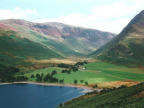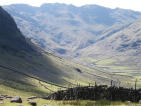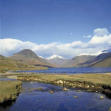
The British Isles is a traditional term used to identify the group of islands off the northwest coast of Europe consisting of two large islands - Great Britain and Ireland, and the many smaller adjacent islands. These islands form an archipelago with total area of 315,134 km2 (121,674 square miles). The Ireland is made up of the Republic of Ireland and Northern Ireland. The United Kingdom is made up of England, Wales, Scotland and Northern Ireland. Great Britain consists of England, Scotland and Wales and doesn't include Northern Ireland.
The British Isles have abundant Paleolithic remains dating back to over 250,000 years ago. Neolithic cultivators came from the southeast, while extensive settlements occurred in the Bronze Age producing Stonehenge and other megalithic monuments as witness to the rich cultures. Celtic peoples invaded Britain in the 6th century B.C, giving us lots of hill and river names. They were the precursors of many of the peoples now living in the mountain areas of the west.
Britain is comparatively small, but there is hardly a country in the world where such a variety of scenery can be found in so small a compass. There are wild desolate mountains in the northern Highlands of Scotland - the home of the deer and the eagles - which are as lonely as any in Norway. There are flat tulip fields round the Fens - a blaze of colour in spring, that would make you think you were in Holland. Within a few miles of the dirt and smoke of Manchester and Sheffield you can be in glorious heather covered moors.
The North Sea and the English Channel separate the British Isles from European continent. Once the British Isles were part of the mainland of Europe - the nearest point is across the Strait of Dover, where the chalk cliffs of Britain are only twenty-two miles from those of France. The Atlantic Ocean and the Irish Sea wash the western coast of Great Britain.
The seas round the British Isles are shallow. The North Sea is nowhere more than 600 feet deep, so that if St. Paul's Cathedral were put down in any part of it some of the Cathedral would still be above the water. This shallowness is in some way some advantage. Shallow water is warmer than deep water and helps to keep the shores from extreme cold. It is, too, the home of millions fish, and more than a million tons are caught every year.
You have noticed on the map how deeply indented the coastline is. This indentation gives a good supply of splendid harbours for ships; and you will note, too, that owing to the shape of the country there is no point in it that is more than seventy miles from the sea - a fact that has greatly facilitated the export of manufactures and has made the English race a sea-loving one.
On the north-west the coasts are broken by high rocky. This is especially noticeable in north-west Scotland, where you have long winding inlets, called "lochs", and a grate many islands.
In Scotland you have three distinct regions. There are, firstly, the Highlands, and then there is the central plain or Lowlands. Finally there are the southern uplands, "the Scott country" with their gently rounded hills where the sheep wander. Here there are more sheep to the square mile than anywhere in the British Isles.
In England and Wales all the high land is in the west and northwest. The south-eastern plain reaches the West Coast only at one or two places - at the Bristol Channel and by the mouths of the rivers Dee and Mersey.
In the north you find the Cheviots, separating England from Scotland, the Pennines going down England like a backbone and the Cumbrian Mountains of the Lake District, one of the loveliest (and the wettest) parts of England. In the west is the Cambrian Mountains, which occupies the greater part of Wales.
The south-eastern part of England is a low-lying land with gentle hills and a coast which is regular in outline, sandy or muddy, with occasional chalk cliffs, and inland a lovely pattern of green and gold - for most of England's wheat is grown here - and brown ploughland with pleasant farms and cottages in their midst. Its rich brown soil is deeply cultivated - much of it is under wheat; fruit growing is extensively carried on. A quarter of the sugar used in the country comes from sugar beet grown there, but the most important crop is potato.
The position of the mountains naturally determined the direction and length of the rivers, and the longest rivers, except the Severn and Clyde, flow into the North Sea, and even the Severn flaws eastward or south-east for the greater part of it.
The rivers in Britain are of no great value as waterways - the longest, the Thames, is a little over 200 miles - and few of them are navigable except near the mouth for anything but the smaller vassels.
In the estuaries of the Thames, Mersey, Tyne, Clyde, Tay, Forth and Bristol Avon are some of the greatest ports.
Very little of the present vegetation, which makes the British scene so green and attractive, is natural; it has been modified, if not promoted, by the activity of man. Even before medieval times, forest clearance had spread to the damp oak woods on the intractable clays of southern England, large areas were felled by the Romans to smelt lead and other ores, and much forest clearance was carried on for naval purposes four centuries ago.
The mountains, the Atlantic Ocean and the warm waters if Gulf Stream influence the climate of the British Isles. The climate of Britain is temperate, and although variations are noticeable, the country does not usually experience any extremes of heat or cold. The British never know what their weather is going to be like for two days running. Winter weather can be cloudy, damp and warm, sunny with frost and snow, or frosty and foggy. Summer weather can be chilly and damp, or hot and sticky, or, on a few glorious days each year, brilliantly sunny and warm with a flawless blue sky.
*Sources: "The British Isles" by C. E. Eckersley & Internet
|
 Vocabulary
1. The British Isles - Британските острови Vocabulary
1. The British Isles - Британските острови
2. off (prep.) - (на разстояние, настрана от) от; край
3. to consist - състоя се, съставен съм (of от)
4. adjacent - близък. близкостоящ, съседен (to)
5. to make up - образувам; формирам; съставям
6. abundant - (из)обилен; прен. богат;
7. extensive - обширен, просторен; прен. широк; дълъг;
8. settlement - 1. селище; колония; ам. село; 2. заселване, колонизиране, колонизация
9. witness - свидетелство, доказателство
10. to invade - завладявам, овладявам
11. precursor - предшественик, предтеча
12. scenery - пейзаж, природа
13. compass - граници, обхват, предел
14. desolate - пуст, безлюден, необитаван
15. tulip - лале
16. the Fens - ниски, равнинни области в източната часта на Англия
17. a blaze of colour - ярки, бляскави цветове
18. heather - вид храст с мали светло-лилави цветове
19. moor - 1. бърдо, пустош, високо пусто поле; 2. ам. тресавище
20. mainland - суша, континент
21. strait - геогр. и рl. пролив
22. chalk - варовик, креда
23. cliff - стръмна скала (особ. край море)
24. shallow - плитък
25. shore - бряг (на море, голямо езеро)
26. to indent - назъбвам, нарязвам; ~ed coastline разчленена брегова линия
27. splendid - блестящ, великолепен, разкошен
28. harbour - 1. пристанище; 2. подслон, убежище
29. owing to - благодарение/вследствие на, поради
30. to facilitate - улеснявам, облекчавам
31. inlet - тесен морски залив; тесен проток между два острова
32. loch - тесен морски залив/ръкав; шотл. езеро
33. distinct - отделен, различен
34. upland - височина, висока местност; рl. планинска, по-висока част на област/страна
35. the Scott country - хълмиста област в югоизточната част на Шотландия, където е живял прочутия британски поет и романист сър Уолтър Скот (1771-1831)
36. hill - хълм, възвишение
37. to wander - скитам се, бродя
38. the Cheviots, the Pennines, Cumbrian Mountains, Cambrian Mountains - главните планини във Великобритания
39. the Cheviots - the Cheviot Hills - район във Великобритания известен с производството на вълна. Породата овце Шевиот дават името на висококачествен вълнен плат.
40. backbone - гръбнак (и прен), гръбначен стълб
41. the Lake District - живописно място с множество езера, станало популярно благодарение на забележителните поети У. Уърдзуърт (1770-1850), Х. Колридж (1796-1849) и Р. Сауди (1774-1843), създали там свой дом и известни под името "езерните поети"
42. gentle - лек, слаб (за наклон, ветрец)
43. outline - очертание, контури
44. inland - вътрешност (на страна)
45. pattern - шарка, десен, мотив
46. wheat - жито, пшеница
47. ploughland - орна земя
48. cottage - къщичка, къщурка; селска къща (u country ~)
49. midst - книж. среда; всред
50. to carry on - водя, продължавам
51. sugar beet - захарно цвекло
52. to flow (into) - тека; вливам се, втичам се (за река)
53. district - област, район
54. estuary - широко устие (на река)
55. Bristol Avon - няколко реки във Великобритания носят името Ейвън. Най-дългата е Бристол Ейвън, която се влива в Бристол ченъл. Но най-популярна в света е тази, която се влива в река Севърн, и на чиито брегове се намира Стратфорд (Стратфорд на Ейвън) - мястото, където е роден най-големият английски поет Уйлям Шекспир.
56. vegetation - растителност, флора; зеленина
57. clearance - изсичане, разчистване (на гора)
58. oak - дъб
59. intractable - неподатлив; упорит
60. clay - глина
61. to smelt - топя, стопявам; разтопявам, произвеждам (метал) чрез топене
62. lead - олово
63. ore - руда
64. temperate - умерен
65. for two days running - два поредни дни, в продължение на два дни
66. damp - влажен; мъглив
67. frost - мраз; скреж; слана
68. chilly - хладен; неприятно студен, мразовит
69. sticky - мокър, влажен, кален (за пьт, време и пр.)
70. flawless - безупречен
|
|
 Weather or whether Weather or whether
Questions1. What parts do the British Isles consist of? 2. What is the total area of the British Isles? 3. What kind of scenery does one find in Britain? 4. Have the British Isles always been separated from the mainland of Europe? 5. What are the seas round the British Isles and what are their peculiarities? 6. What is the advantage of shallow water? 7. Describe the British coatline and discuss its advantages. 8. What is characteristic of the north-west coast of Britain? 9. What is the relief of England, Scotland and Wales? 10. Where are the main mountains in Britain found? (the Cheviots, the Pennines, the Cumbrian, and the Cambrian Mountains) 11. What do you know about the south-eastern part of England? 12. What usually determines the direction and the lenth of rivers? 13. Where do the longest rivers in Britain flow into? 14. Is the present British vegetation only natural? 15. Describe the climate in Britain.
|
G a l l e r y   
     |
|
Test it out!
Fill in with prepositions:
|
More facts...- The British Isles consists of: Great Britain, Ireland, The Isle of Man, The Isle of Wight, The Orkney Isles, The Shetland Isles, Fair Isle, The Hebrides, The Small Isles, Anglesey, Lindisfarne, The islands of the lower Firth of Clyde (including Arran and Bute), The Isles of Scilly, Lundy, Looe Island, The Channel Islands and many other smaller islands surrounding the islands of Great Britain and Ireland.
- The Isle of Man and the Channel Islands are not part of the United Kingdom. They are largely self-governing with their own legislative assemblies and systems of law. The British Government is, however, responsible for their defence and international relations.
- Britain comprises Great Britain (England, Scotland and Wales) and Northern Ireland, and is one of the member states of the European Union (EU). Its full name is the United Kingdom of Great Britain and Northern Ireland.
- The term 'Great Britain' was first officially used in 1604 when King James I of England (James VI of Scotland) was proclaimed 'King of Great Britain'. Prior to this, it was used by some writers to distinguish Britain from Brittany, in France.
- The United Kingdom has a very long history. Many times it was invaded by conquerors from abroad: the Romans, the Vikings, et cetera. It was waged many wars, has had a very strong army and especially navy, and has always played an important part in world politics.
- England was added to the Roman Empire in 43 AD. Under Queen Elizabeth I (second half of 16. century) Britain became a major sea power. Large parts of Africa and Asia were added to the empire during the reign of Queen Victoria (second half of the last century).
- The population of United Kingdom is about 60 million people of various natiolalities. The total population of England is estimated at 49.5 million, Wales is estimated at 2.9 million, Scotland at 5.1 million and Northern Ireland at 1.7 million people. England has the highest population density and Scotland has the lowest.
- Besides the English, the Scottish, the Welsh and the Irish, there are many immigrants from numerous countries, including former British colonies in Africa, Asia and America. The largest ethnic minorities in Britain are those of Caribbean or African descent (891,000 people). The next largest ethnic groups are Indians (840,000 people), and Pakistani and Bangladeshis (640,000 people).
- The capital of England (and the UK) is London. Edinburgh is the capital of Scotland, Cardiff is the capital of Wales and Belfast is the capital of Northern Ireland. (Dublin is the capital of Republic of Ireland.) Politically, Britain is a parlamentary monarchy with strong democratic traditions. Nominally, the country is ruled by the King or the Queen. But in fact, the real head of the state is the Prime-Minister.
- The Constitution of the UK is unwritten; it is based on custom, tradition and common law. The main body is Parliament. It consists of the House of Commons and the House of Lords. British parliamentary system is one of the oldest in the world (13th century) The Prime Minister appoints a team of main ministers as the Cabinet. There are two main political parties: the Labour Party (left) and the Conservative Party (right).
 L i b r a r y L i b r a r y
Great BritainGreat Britain consists of three parts: England, Scotland and Wales. Northern Ireland belongs to the United Kingdom and borders on the independent Irish Republic, which occupies a bigger part of the island.
Great Britain has some mineral resources, first of all, the deposits of coal and iron ore, which were the basis of British industrial revolution. Vast deposits of oil and gas were discovered in the North Sea.
Now Great Britain is highly developed industrial country, one of the leading states of the world. Among its biggest industrial cities London come first. It is the main centre of the industries producing clothing, food and drink and many other specialized goods. It is an important centre for light engineering and chemicals and has some heavy engineering plants. London is a great port with numerous docks. It is also a centre of commerce.
To the north-west of London are the Midlands, an important industrial district known as the "Black country". Birmingham, the centre of the district, produces iron goods, machinery, chemicals, etc. Nearby are the largest coal and iron fields in Britain. Further north is Manchester, the centre of the cotton industry. It is connected with Liverpool, the second largest port in Britain, by a canal through which ocean-going steamers carry raw cotton to the cotton mills of Manchester and finished products to every part of the world. The Black Country is also the main centre of armaments production.
To the east of Manchester is the city of Sheffield, famous for its steel manufacture, tool industry and heavy engineering. A short railway journey to the northeast will take you from Manchester to Leeds, the chief centre of the woollen industry. Further to the north on the North Sea coast is Newcastle, famous for its shipbuilding yards and its export of coal.
In Scotland the Lowlands are by far its richest part. Here are coal and iron fields and the largest shipbuilding yards. Glasgow is the largest city, seaport and trading centre of Scotland.
The south of England is rural. Here we find fertile valleys with well-cultivated fields and pastures. The southeastern coast is celebrated for its picturesque scenery and mild climate and a number of popular resorts. On the southern coast of England we find many large ports: Portsmouth, Plymouth and others.
to border (on, upon) - гранича (с)
coal - каменни въглища
steamer - параход
raw - суров, необработен
armament - въоръжение (обикн. рl)
fertail - плодороден
pasture - пасище
resort - курорт

|










